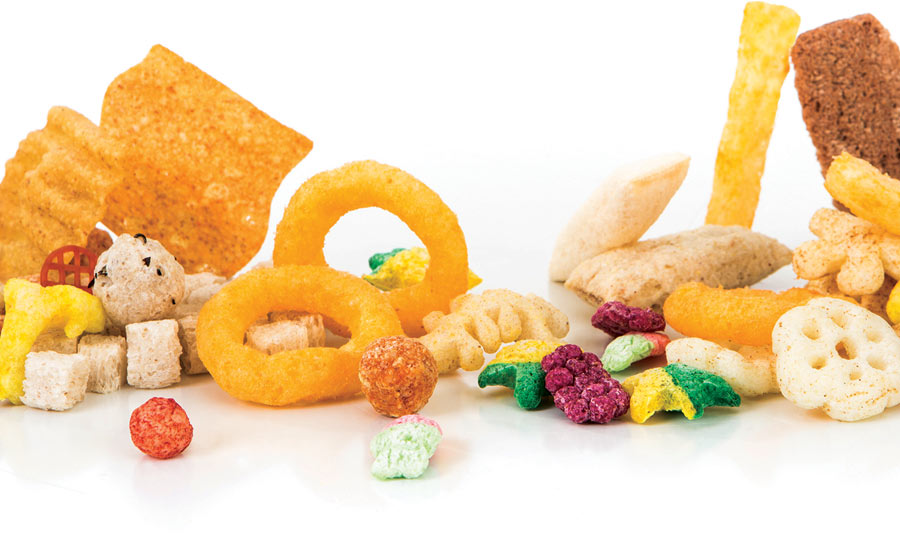Puffed and extruded snacks seek bases with better nutritional benefits
Consumers seek non-traditional proteins in puffed and extruded snacks




Puffed and extruded snacks, a subset of the salty snacks category, continue to rise in popularity as snack producers continually bring ingredient and product format innovations to the table.
According to data from IRI, Chicago, for the 52 weeks ending September 8, 2019, the “other salted snacks” segment—home to iconic products like Funyuns, SunChips, Garden Veggie Straws and Pirate Booty—was up by 8.5 percent and $4.8 billion in sales.
Frito-Lay leads the segment, with its brands growing 10.4 percent to $3.2 billion. The top three brands in the segment—all Frito-Lay products—were all up over 10 percent: Funyuns grew 10.1 percent to $423.6 million, Chester’s grew 10.6 percent to $327.1 million and SunChips grew 10.8 percent to $292.4 million. Frito-Lay’s still relatively new Poppables brand continued its path of growth, up 36.1 percent to $106.6 million. Also, the Hain Celestial brand Sensible Portions saw its Garden Veggie Straws brand grow a healthy 16.9 percent to $95.6 million.
The cheese snacks segment grew 14.1 percent to $2.7 billion. The Frito-Lay brand Cheetos commands this segment, and continues to grow, up 9.3 percent to $1.9 billion for the year. Frito-Lay’s Chester’s brand sits in the distant No. 2 slot, and likewise saw growth, up 5.3 percent to $144.5 million. The Simply Cheetos brand also continues to gain ground, up a significant 46.1 percent to $100.2 million.
Dehydrated cheese products continue to gain significant ground. Arthur Schuman’s Cello Whisps grew 106.7 percent to $37.7 million. And ParmCrisps—a That’s How We Roll brand—which prominently bills itself as a keto-friendly snack, jumped an astonishing 157.7 percent, with total sales of $9.1 million.
The corn snacks segment was up 4.8 percent to $1.2 billion in sales, per IRI. The top three products in the segment are all from Frito-Lay’s namesake Frito’s brand: Fritos were flat, down 0.2 percent to $518.0 million; Fritos Scoops grew 4.9 percent to $241.4 million; and Fritos Flavor Twists grew 12.8 percent to $156.1 million. Frito-Lay is also seeing traction with its Latin American Sabritas Crujitos twisted corn snacks, up 12.8 percent to $1.7 million, and its Sabritas Churrumais, up 13.8 percent to $1.6 million.
Of particular note in corn snacks is the continued growth BFY Brands products. Its Our Little Rebellion brand—now rebranded as PopCorners Flex Protein Crisps—grew 43.2 percent to $45.2 million. And its regular PopCorners products grew 176.2 percent to $2.7 million in sales.
The pork rinds segment of salty snacks continues to perform well across the board, up 15.1 percent to $577.3 million. Frito-Lay’s Baken Ets, the segment leader, grew 3.4 percent to $139.1 million in sales, while Mac’s Snacks gained considerable ground, up 38.7 percent to $86.0 million. Rudolph Foods saw its Southern Recipe brand grow 55.5 percent to $9.8 million. Private label pork rinds saw fantastic growth for the year, up 108.9 percent to $41.3 million. And the 4505 brand saw another great year, up 148.4 percent to $5.5 million in sales.
Top trends
Innovation in snack substrates continues to factor into new product development. “A huge trend is the use of alternate bases—those other than corn—and use of natural colors and flavors,” says Nick Desai, CEO, PeaTos, Los Angeles. “People want to feel like they’re doing something to help their eating habits, but still feel the indulgence. Additionally, peas jumped into the national spotlight this year thanks to two factors: sustainability and health. In terms of sustainability, peas are drought-tolerant, reduce the need for nitrogen fertilizers and are ideal for crop rotation.”
Nearly 800 new pea-related foods hit the shelves in 2018, reports Desai. Over this year, PeaTos released a new Classic Cheese multipack in May, and a Ranch flavor in March. PeaTos is also introducing a new product format, Crunchy Rings in Classic Onion and Fiery Onion flavors.
Chad Rieschl, senior research food technologist, Cargill, Minneapolis, also says that he has noticed the emergence of more products made with low or no grains. “You see this in the cereal space, where product developers are using milk or other protein sources as the base, then adding a low-carb, low-sugar or even low-salt coating.”
Scott Sturgill, vice president of product development and innovation, FitJoy, Austin, TX, is seeing a lot of innovation in puffs—which makes sense, since puffs are one of the most-popular snack formats, he notes. “Some of the trends we’re seeing are high-protein and low-carb puffs (keto-friendly), pulse-based alternatives to corn or rice puffs, protein puffs made from plant proteins, Paleo-friendly puffs, vegan puffs, and egg white puffs,” he says. Pulses include bean and peas, and vegan puffs include traditional cheese flavors, but made without dairy.
In August, FitJoy released its Grain Free Protein Puffs, which are keto-friendly and also grain-free for those looking to cut grains from their diet, notes Sturgill. They come in three flavors: Honey Sriracha, Nacho Cheese and White Cheddar.
There is a trend toward “smart” snacks, with healthy attributes that let consumers feel good about their choices, says Gilles Maller, vice president, sales and international, Clextral Inc., Tampa, FL. “These snacks typically have less sugar and fat—unless it’s ‘good’ fat from nuts or vegetables, such as avocado or olives—and increased protein content. Puffed vegetable snacks are a fast-growing segment of this market.”
On the other hand, Maller is also seeing more interest in sweet snacks, such as snack puffs with confectionary coatings. “These differ from traditional indulgent snacks, as their ingredients allow label claims of nutritional benefits.”
Harvest Snaps released new holiday flavors in August that fit this trend, coming in Salted Caramel and Cinnamon Brown Sugar. The snaps are baked, feature non-GMO red lentils as the first ingredient, and are only 130 calories per serving, with 6 grams of plant-based protein and 3 grams of fiber in every serving.
“Consumers are also attracted to snacks that ‘tell a story,’ perhaps with a regional or a grassroots origin,” says Maller. “Organic ingredients and sustainability play into this trend.” Millennials also continue to impact snacking as they embrace adventurous flavors and globally influenced snacks, he adds.
Production insights
“With extrusion as a modern key technology, new developments for snack products can be prepared at lab scale,” says Michael Landers, application technician, Brabender GmbH & Co. KG, Duisburg, Germany. “Innovative foods are made possible by varying the parameters of screw speed, temperature and shear during their interaction at extrusion.”
Brabender’s TwinLab twin-screw extruder enables contemporary and flexible product design using a range of raw materials, says Julian Foerster, application technician. “Not just ‘classic’ corn, wheat, rice or soy, but also with legumes such as peas, lentils or lupines. Above all, this also includes innovative products made with potatoes, vegetables or nuts in the snack segment. Raw material mixtures with fibers, oils, sugar or micronutrients are also possible.”
Foerster says that the ability to facilitate ongoing development of new products is indispensable. “The food industry and consumers wish to have interesting products—preferably with added value in terms of taste and health. We at Brabender believe that extrusion as a technical application will play a key role for new consumer goods,” he remarks.
The many ingredients available today bring new and interesting flavors, textures and nutritional benefits to snacks, says Maller. “These range from protein-rich ingredients, including chickpeas, black beans, soybeans, quinoa, sorghum and spelt, to vegetables such as beet, spinach, carrot, mushroom, cauliflower, broccoli and kale.”
Puff-making is pushing into new territory, says Sturgill. “A few years back, it was very difficult to make puffs with ingredients other than corn, rice or wheat. There were also very few grain-free substrates available. Consumers are looking for snacks made with more nutritious ingredients, and many are looking for ways to cut grain from their diet.”
Traditional snack ingredients including corn, oats, wheat and rice may be combined in new recipes with non-traditional raw materials, such as vegetable powders and other high-protein grains or pulses, to achieve specific flavor or nutrient profiles that are valued by health-conscious consumers, Maller notes. “However, there is sometimes a challenge in maintaining the quality and quantity when sourcing exotic ingredients.”
Maller notes that the twin-screw extruder helps streamline many processing scenarios, and can run small amounts of sample snacks for evaluation. “This is particularly helpful when processing expensive ingredients. The twin-screw extruder cooks and processes a wide range of raw materials in terms of starch, protein and fat content to create snacks that are crispy, crunchy, grainy, light-textured and more.”
The benefits of this flexibility continue to the processing line, where one extruder can capably run multiple products with simple changes of production parameters and/or recipes. which can greatly reduce capital equipment costs, says Maller. “Clextral extruders have auto-open barrels that allow immediate screw access for reconfiguration and cleaning to simplify changeover. They also have a hygienic design that reduce the time required for cleanup and sanitation. New ingredients and recipes, combined with the processing flexibility of the twin-screw extruder, allow processors to develop and commercially produce a wide range of snacks to keep consumers coming back to their brands.”
Brands are shining the spotlight on ingredients when crafting products that embrace broader consumer trends, says Rieschl. “For example, we’re seeing keto-esque products that combine low-carb/low-sugar formulas with ancient—or at least less-processed—grains, and lots of protein.” And if they’re made with trendy plant proteins like pea, all the better, he notes.
To keep sugar levels in check, product developers are turning to sweeteners like stevia, often paired with erythritol, Rieschl explains. “We’re also seeing more interest in reduced sodium, with product developers using potassium chloride to replace some of the salt, yet still maintain flavor.”
Consumers continue to express snack options with a nutritional edge, says Rieschl. “Puffed and extruded products, with their ‘baked not fried’ halo, provide the perfect format to deliver on those demands—whether that means creating products with added fiber or protein, or reducing sodium or sugar levels. The key is to deliver on those better-for-you demands, and at the same time, provide a snack experience with a distinctive flavor and texture that keeps consumers coming back for more.”
Desai says that the innovation has to come from both the raw materials and the equipment side. “Extruding high-protein, raw materials like peas is harder than extruding corn—and has more nuances. Also, the seasoning houses must develop lower-cost, natural colorants, flavors and more that are as appealing and impactful as their artificial counterparts. Consumers don’t want to eat better by trading the eating experience. Those days are behind us.”

Looking for a reprint of this article?
From high-res PDFs to custom plaques, order your copy today!








